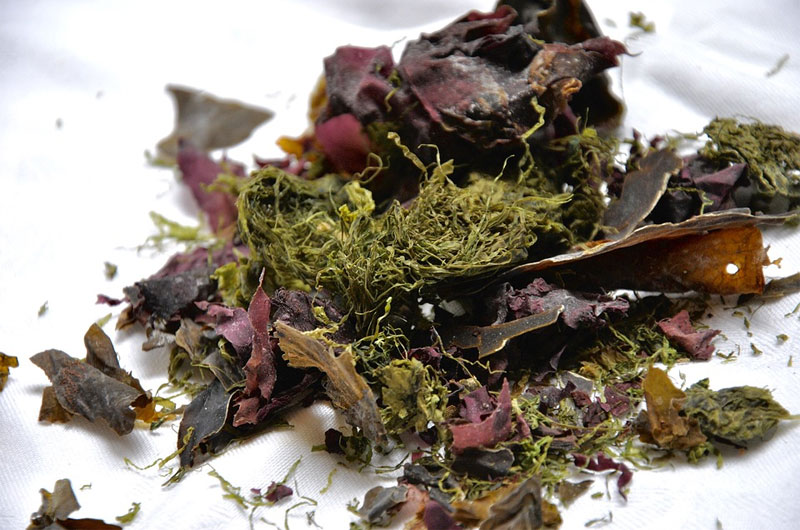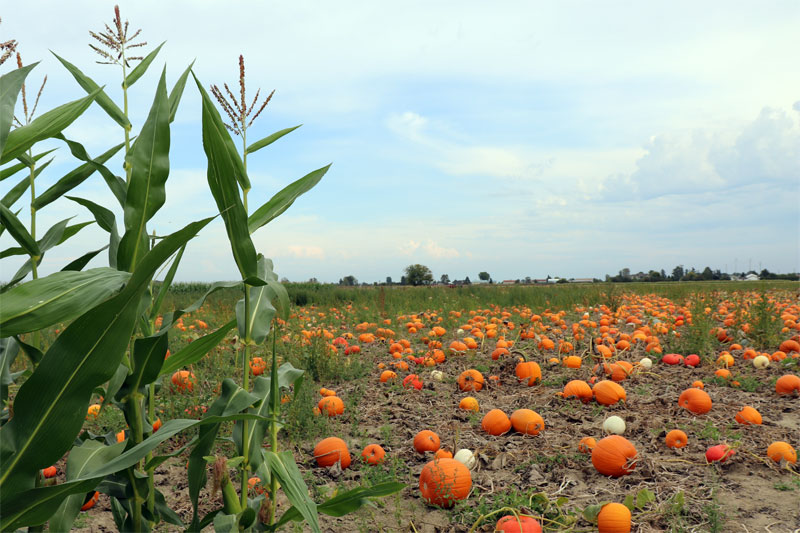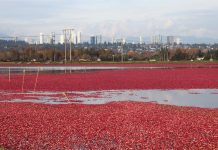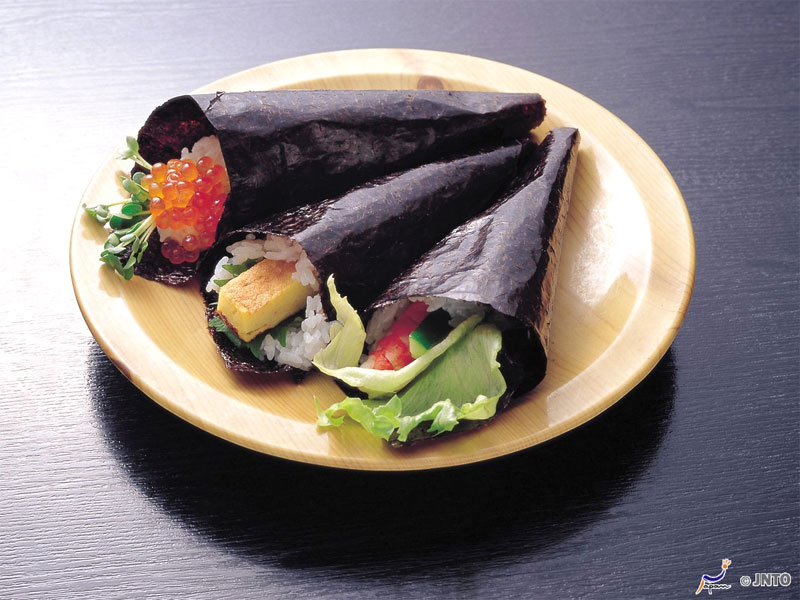Hand roll sushi: ingredients (usually seafood) wrapped in cone-shaped using a single piece of seaweed (©Saga Prefecture/©JNTO)
Updated: November 29, 2016
Why is seaweed popular? What’s in eight grams of seaweed that you can find in 100 grams of raw sirloin steak? How can this algae benefit your health?
The table colours are changing. Make way meat…plants are taking centre plate as North American consumers seek healthier lifestyles. Specialty Food News forecasts vegetables will top the list substituting animal-based proteins and high carbohydrate foods. Leading the way is seaweed.
Macro Algae on Your Plate
The driving force behind this super food’s demand is its sustainability, high nutrition content, medical value and flavourful appeal. They look unattractive, but these edible algae are packed with minerals (calcium, potassium, magnesium, sodium, copper, iron and iodine), vitamins (A, B, C, E), fibre, essential fatty acid (omega 3 and 6) and protein.
In the article, Nutritional Value of Edible Seaweeds published in Nutrition Reviews (Vol. 65, No. 12) by the International Life Science Institute, researchers cited that:
- Protein content in Nori (Porphyra species) can reach up to 47% of its dry weight, depending on season and species.
- Alginates from brown seaweeds exhibit potential benefits for gut health, favourable in colon cancer prevention.
- Various types of antioxidants, e.g. those present in vitamins and protective pigments exist in seaweed due to immense exposure to direct sunlight. Sea lettuce (Ulva lactuca) has high Vitamin C content.
- Minerals like iron and copper in seaweeds are higher compared to those in meats and spinach.
8-grams of dry Dulse (Palmaria plamata) has more iron than 100-grams of raw sirloin steak.
Health Benefits
- Prevent colon cancer
- Curb gastrointestinal inflammation
- Foster probiotic action in gut
- Fight influenza virus
- Regulate weight gain – increase satiety and reduce appetite.
- Lower risk of cardiovascular disease
- Control blood glucose level in type II diabetes
Red seaweeds, especially lavers (Porphyra sp.) are good sources of taurine, said researchers in the study on Proximate Composition, Amino Acid, Mineral, and Heavy Metal Content of Dried Laver. The study also cited findings by other scientists that taurine aids in fat digestion, and fat-soluble vitamin absorption – increased dietary intake of taurine may benefit heart health, battle diabetes and hypertension. Taurine is a main ingredient of bile found in the human liver.
Kelp, Nori, Karengo – What are they?
Fresh seaweeds come in a range of red, green and brown shades and pigmentation. These rootless macro algae live off inorganic saltwater nutrients and sunlight for photosynthesis. Thousands of species thrive in coastal waters around the world, but only 300 to 400 types (cultivated or wild) are harvested for commercial use, states the Seaweed Industry Association.
Sea Wrack, Sea Spaghetti, Sea Lettuce, Sea Grass, Dulse, Irish Moss, Carrigeen, Kombu, Wakame and Nori are some common seaweed names. Kelp is a generic name for brown seaweeds like Wakame, Kombu and Dulse. Nori, a red variety originates from many culivated Pyropia and Porphyra species. In New Zealand, Karengo, a Maori delicacy, is a close relative of Nori.

Versatile Plant and Valuable Food Source
Seaweed is harvested for use as a cleaner, fertilizer, animal and fish feed; in the manufacture of personal care product and cosmetics; as a food ingredient and additive.
Commercially, seaweed is extracted for its gelatinous elements: alginate, agar and carrageenan, collectively labelled hydrocolloids or phycocolloids.
Edible seaweed are sold in fresh, frozen, cooked and dried (flake or sheet) forms. East Asian (China, Japan and Korea) and Canadian First Nations coastal communities have been using seaweed as a cooking ingredient for centuries.
Wakame is commonly added to traditional Japanese miso soup (dashi stock), salad and rice, even used as a natural remedy.
In North America today, seaweed has become a mainstream snack and health supplement – example, the blue-green algae: spirulina and chlorella.
Seaweed Producers
FAO (United Nations Food and Agriculture Organization) 2013 statistics revealed China (50.1%) as the world’s largest seaweed producer, followed by Indonesia (34.6%) and Philippines (5.8%). Wild seaweed stocks have dwindled over time. Cultivated species now supply 90% of the world’s demand.
With the rapid growth in marine culture, Indonesia is set to beat China as the world’s largest seaweed producer. Currently, most seaweeds produced in Indonesia are shipped to China and Philippines for processing, says Den Yealta Head of the Tanjung Pinang Free Trade Zone, Riau Islands. Her government will be working with Riau University to research and develop a plant to process Nori this year.
Seaweed Shopping
Check out your local Asian (Chinese, Korean, Japanese) markets. Fresh seaweeds are usually sold in bulk in the seafood area. They look slimy; taste salty (red and green type), a bit fishy, chewy in texture, and best kept in the fridge for freshness. Dehydrated seaweeds can be found in the dry goods section. Alternatively, try the health food stores or natural grocers.
A Note of Caution: seaweeds harvested from polluted waters will highly contain toxins, so don’t consume large quantities unless you know their ORIGIN.
How to Prepare Seaweed?
- Rinse your fresh seaweeds in water, stir-fry or boil them.
- Finely chopped fresh seaweeds, add to your salad, soup, pasta, stew or pizza.
- Marinate your fresh seaweeds in vinegar or tamari(Japanese soy sauce).
- Make your own sushi roll: take some cool cooked rice, add your favourite filling like vegetables with cream cheese or meats, and roll it up in a Nori sheet.
- Cut your Nori sheets and toss it with your salad or eat is as a snack.
- Make seaweed chips by brushing cut-up Nori sheets with olive oil and baking them for about 15 to 20 minutes at 275°F.
Iodine level varies depending on seaweed species. If you are iodine-sensitive or have any type of medical condition, consult with your medical specialist prior to consuming seaweed.
Links
Seaweed Information:
Seaweed Industry
Seaweed Site






































